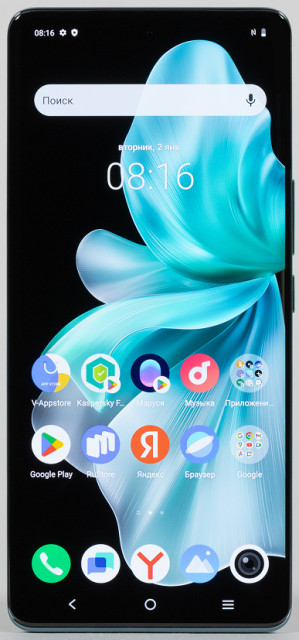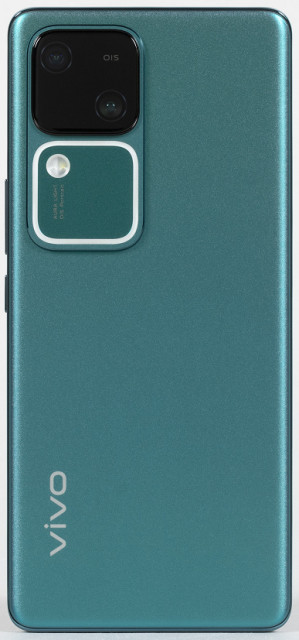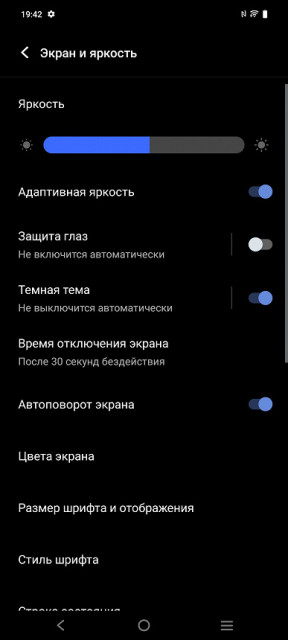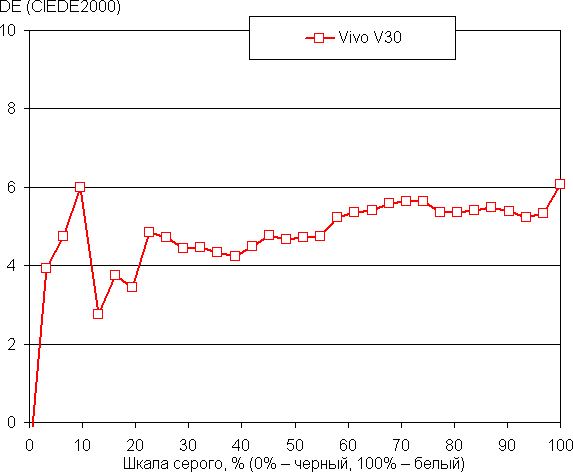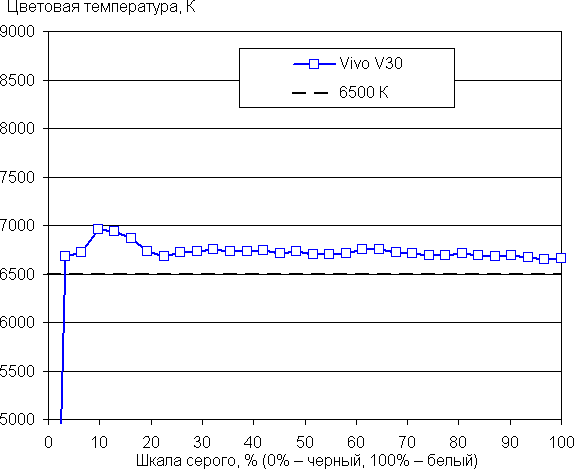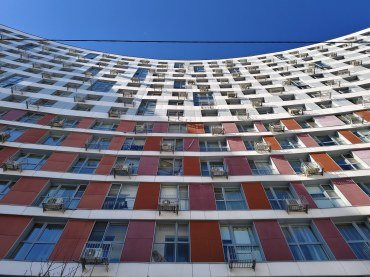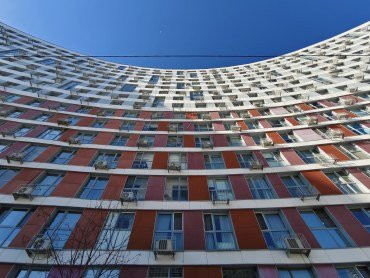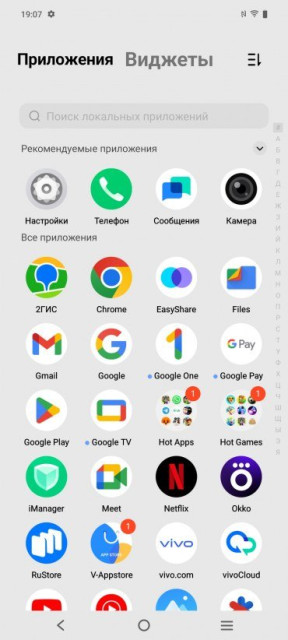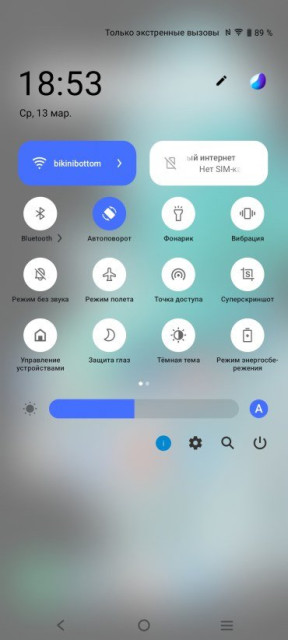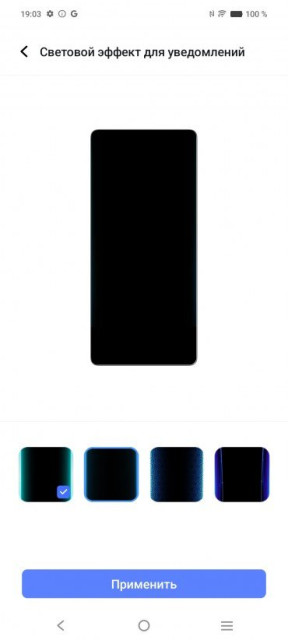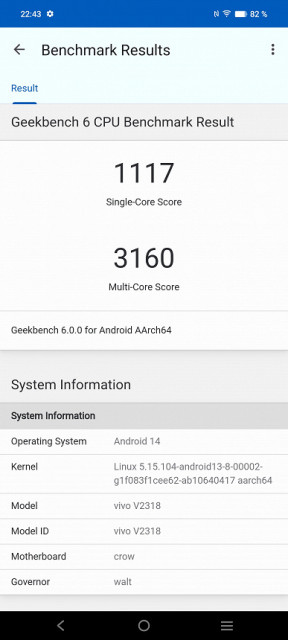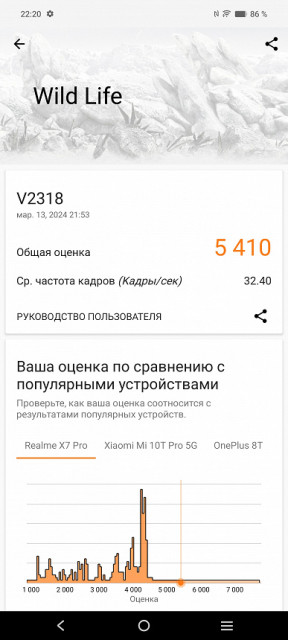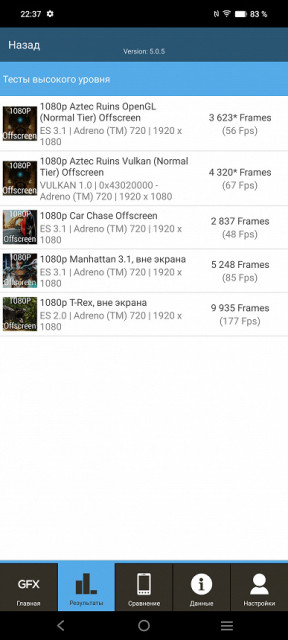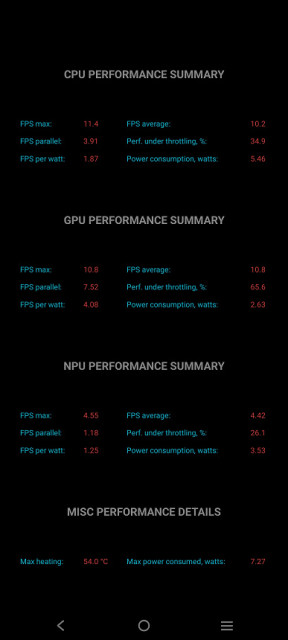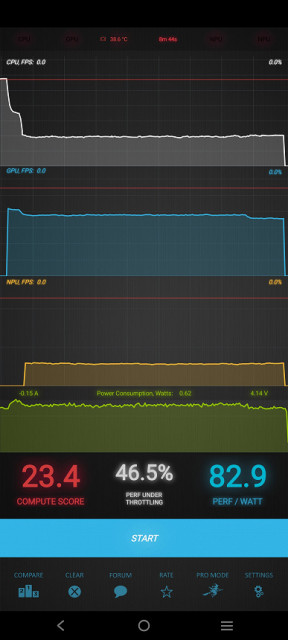Vivo V30 is the next generation of smartphones in the mid-range segment of the Vivo lineup. This device is an improved version of last year's Vivo V29. It offers an attractive body design, a unique Aura ring light, a curved waterfall display, a powerful Qualcomm platform, quality cameras and other innovations. In our full review of the new product, we will look at all these features in more detail.

Key Features of Vivo V30 (Model V2318)
- SoC Qualcomm Snapdragon 7 Gen3, 8 processor cores (1×Cortex-A715 @2.63 GHz + 3×Cortex-A715 @2.4 GHz + 4×Cortex-A510 @1.8 GHz)
- GPU Adreno 720
- Operating system Android 14, Funtouch 14
- Touch display AMOLED, 6.78″, 1260×2800, 20:9, 453 ppi, 120 Hz
- RAM 12 GB LPDDR4X, internal memory 256/512 GB UFS 2.2
- No microSD support
- Support Nano-SIM (2 pcs.) and e-SIM
- Networks 2G GSM, 3G WCDMA, 4G LTE, 5G
- GPS, Glonass, BDS, Galileo and QZSS
- Wi-Fi 6 (2.4 and 5 GHz)
- Bluetooth 5.4, A2DP, LE, aptX HD, aptX Adaptive, aptX Lossless
- NFC
- USB 2.0 Type-C, USB OTG
- There is no 3.5mm audio output for headphones
- Cameras 50 MP + 50 MP (wide-angle), video 4K@30 fps, 1080p@60 fps
- Front camera 50 MP
- Proximity and lighting sensors, magnetic field, accelerometer, gyroscope
- Fingerprint scanner (under the screen)
- Battery 5000 mAh, charging 80 W
- Dimensions 164×75×7.5 mm
- Weight 186 g
Appearance and ease of use
The Vivo V30 smartphone comes in a hard cardboard package with the most discreet design.

The kit includes an 80 W power supply, connecting cable and a transparent flexible case.
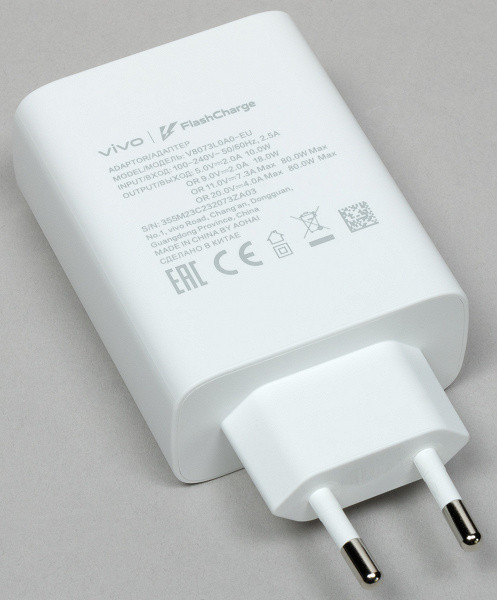
The design of the Vivo V30 remains largely unchanged compared to its predecessor, the Vivo V29. This means that the thin and slippery bezels on the sides of the device are retained, as well as the curved screen with a waterfall effect. Visually, the device looks stylish, premium and attractive, but it does not feel very secure in the hand and can slip due to its design.

The smartphone has quite large dimensions, but it is thin and light. Thanks to the narrowed side panels, the body appears visually and tactilely to be even thinner than it really is. Despite the fact that the Vivo V series device has previously had a thin design, in this model the battery has become more capacious, while the thickness of the body has remained at the same level.

The back panel of the case is made of glass with a matte finish, which feels hard and slightly rough to the touch. Fingerprints on it are almost invisible. The front glass surface already has a factory-installed protective film.
The side buttons are thin, elastic, and conveniently located on one right side.

The camera block on the rear panel is designed symmetrically and aesthetically. However, its huge size is striking, especially considering the adjacent square block with an LED flash, which has already become a characteristic feature of models with the Aura series.
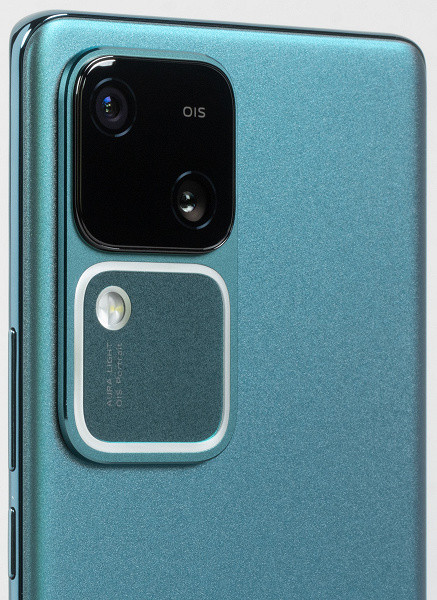
The rear cameras protrude, making the smartphone unstable on a flat surface. However, the included case, made of flexible and transparent material, has a protruding rim around the cameras that protects them from direct contact with the table surface.
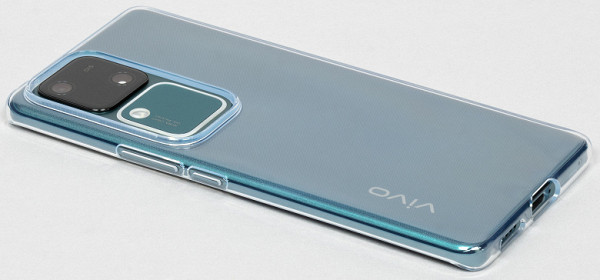
A single front camera eye is installed behind a circular cutout in the screen matrix right in the center of the top edge.
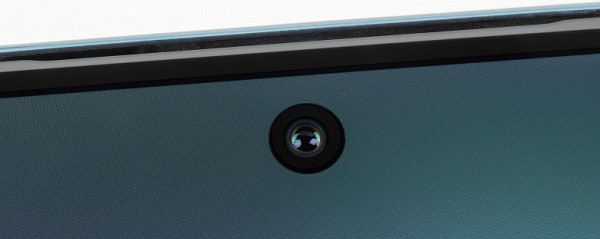
The fingerprint scanner is located under the bottom of the screen glass. The sensor is optical and responds more or less quickly, but this solution is still less convenient than the side button.
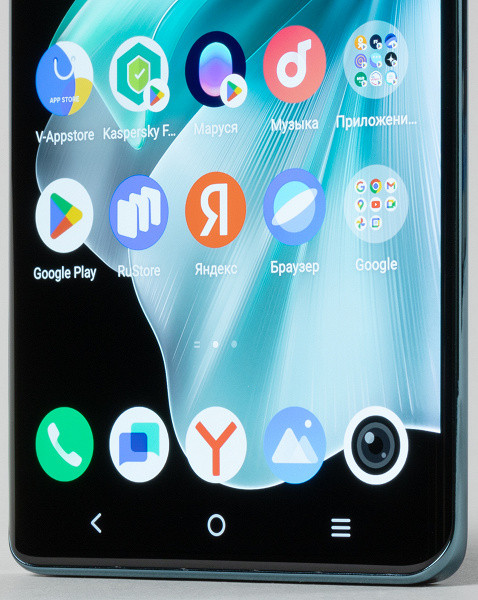
The slot on the bottom can accommodate two Nano-SIM cards (on one side and the other side of the sled). Installing a microSD memory card is not supported.
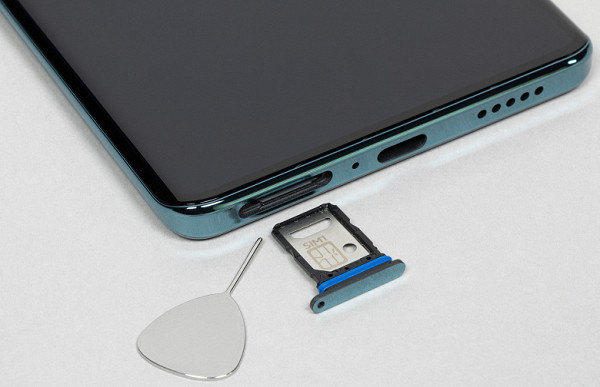
A speaker, microphone and USB Type-C connector are also installed here at the bottom end. There is no 3.5 mm wired headphone output.

The top end contains an additional microphone and an immodest Professional portrait inscription, but there is no second speaker for stereo effect.

The Vivo V30 smartphone is available in several design options, but in Russia only two colors are offered: “Dark Matter” and “Emerald Forest” (black and green). The smartphone case is protected from water and dust in accordance with the IP54 standard, which provides protection against splashes of water and allows you to use the touch screen even with wet fingers in the rain, but does not provide for complete immersion of the device in water.
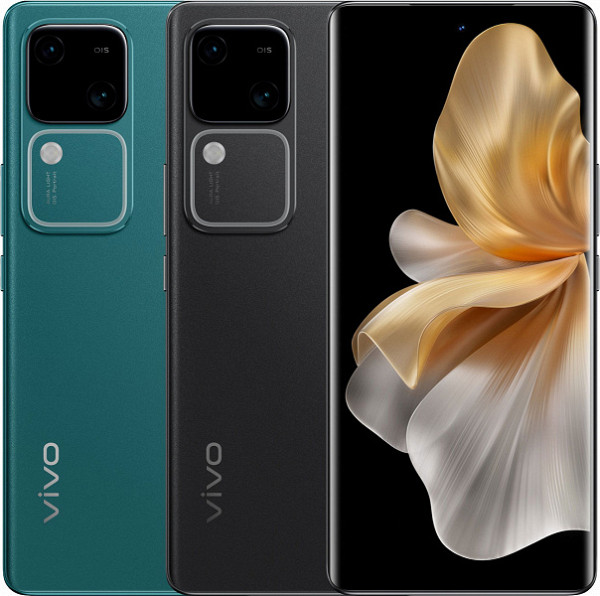
Screen
The Vivo V30 smartphone features a 6.78-inch AMOLED display with a resolution of 1260×2800 pixels, protected by Schott Alpha curved-edge glass. The physical dimensions of the screen are 71x157 mm, the aspect ratio is 20:9, and the pixel density is 453 ppi. The frame width around the screen is 2mm on the sides, 3mm on the top and 3.5mm on the bottom. The screen supports a refresh rate of 120 Hz and HDR10+ technology.
The front surface of the Vivo V30 screen is made of a glass plate with a mirror-smooth surface that is scratch-resistant. The screen's anti-glare properties are superior to those of the Nexus 7, and the oleophobic coating makes it much easier to remove fingerprints.
The maximum screen brightness is about 500 cd/m² in normal conditions and up to 900 cd/m² in bright light, which ensures good readability during the day. The minimum brightness is 2 cd/m², which allows you to use the device in the dark. Automatic brightness control ensures adequate screen brightness depending on lighting conditions.
At high and medium brightness levels there is modulation with a frequency of about 60 or 120 Hz, which can affect the comfort of using the device.
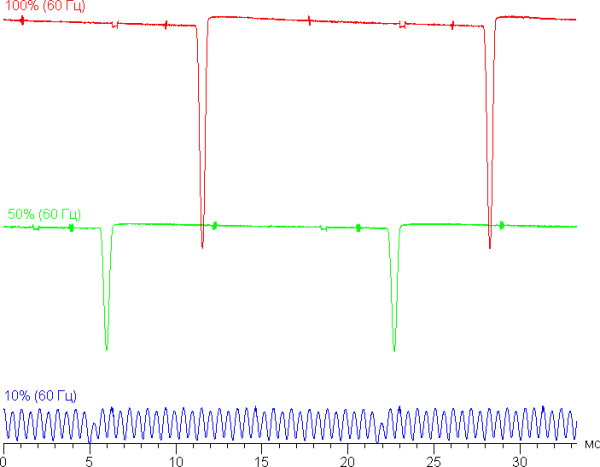
At high and medium brightness levels, the screen duty cycle is low, eliminating visible flicker. When the brightness is greatly reduced, modulation appears at a high frequency (1.92 kHz), which also does not cause visible flicker.
In the screen settings there is an option to activate a mode with an increased refresh rate of up to 120 Hz.

In 120 Hz mode, scrolling through menu lists is noticeably smoother. It's important to note that the boost to 120Hz only occurs for fast-paced content and only in apps that support high refresh rates in their settings. In the case of a static image, the refresh rate is automatically reduced to 60 Hz. Let's see how this affects the modulation pattern:
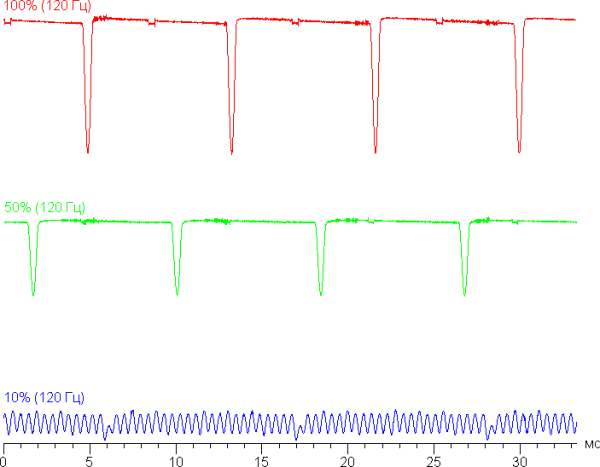
The modulation frequency at high and medium brightness increased to 120 Hz, and at low brightness to 2.16 kHz. As a result, there is no visible flicker.
This screen uses an AMOLED (active matrix organic light emitting diode) panel. A full-color image is created using subpixels of three colors: red ®, green (G) and blue (B). However, the number of red and blue subpixels is half that of green, which is referred to as RGBG. This is confirmed by a fragment of a microphotograph.
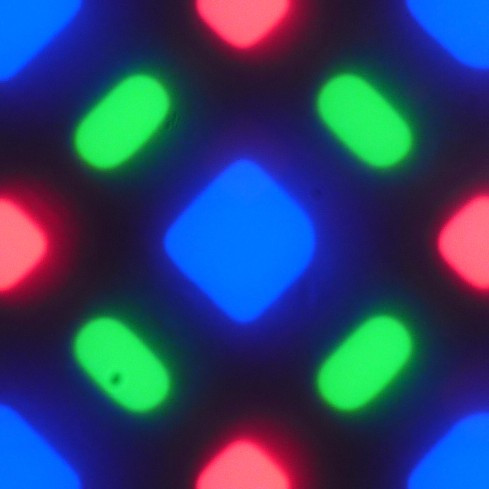
In the fragment above you can see 4 green subpixels, 2 red (4 halves) and 2 blue (1 whole and 4 quarters). By repeating these fragments, you can fill the entire screen without gaps or overlaps. For such matrices, Samsung uses the term PenTile RGBG. Screen resolution is calculated based on green subpixels, so it is lower for the other two. There is some edge contrast and other artifacts, but due to the high resolution these have minimal impact on image quality.
The screen has excellent viewing angles. At high angles, the white color takes on a slight blue-green tint, but the black color remains unmatched at all angles. It is so saturated that the contrast setting simply becomes unusable. For comparison, here are photographs in which the screens of a smartphone and another device display the same images. The brightness of the screens is initially set to approximately 200 cd/m², and the color balance on the camera is forced to switch to 6500 K.
Perpendicular to the screens is a white field.
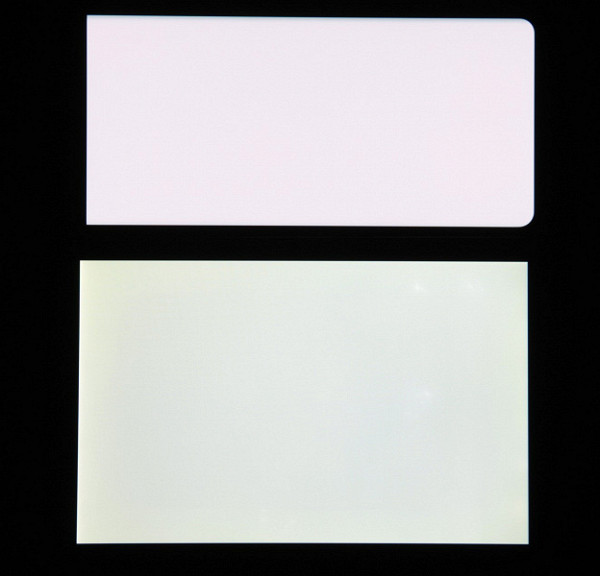
We note good uniformity of brightness and color tone of the white field (with the exception of barely visible darkening and a change in hue towards the curved edges).
And a test picture (Pro Mode profile):

According to the visual assessment, the colors on the tested screen look more or less natural, but the color balance is slightly different from other screens. It is worth noting that the photograph cannot be a completely reliable source of information about the quality of color reproduction and is provided for illustration purposes only. There is a pronounced reddish tint to white and gray areas in photographs, but when looking directly at the screen this effect is not so noticeable, as confirmed by the results of hardware tests using a spectrophotometer. This happens because the spectral sensitivity of the camera matrix does not exactly match the characteristics of human vision.
It's also worth noting that the image in the photo takes up the entire available screen area and extends to its curved edges, which may result in some darkening and color distortion. In addition, when viewed in bright light, these areas are often subject to glare, which can also interfere with viewing images full screen. Even images with a 16:9 aspect ratio can extend slightly off the screen due to its curved edges, which can be awkward when watching videos.
The photo in question was taken after selecting the Pro Mode profile in the screen settings, available in a total of three options.
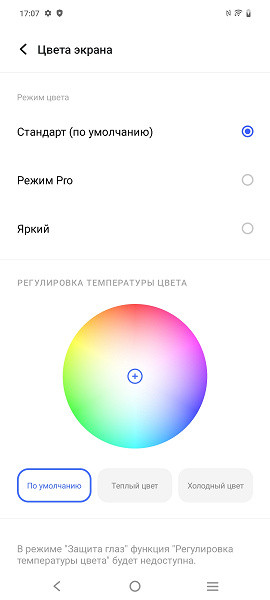
When you select the first one, Standard, which is set by default, the colors are oversaturated and unnatural:

This profile has a good approximation to DCI coverage (see below). When choosing the Vivid profile, the color saturation is even higher:

This device also has the ability to adjust the color balance by selecting a color temperature profile or adjusting the hue on the color wheel.
There is a decrease in brightness at viewing angles on both screens, but on the smartphone this is less noticeable. As a result, even with the same formal brightness, the smartphone screen appears visually brighter, especially when the screen is viewed from a slight angle.
Switching the state of the matrix elements occurs almost instantly, however, when turned on (and sometimes when turned off), a step of about 17 ms (at a screen refresh rate of 60 Hz) or about 8 ms (120 Hz) can be observed. Below is the dependence of brightness on time during the transition from black to white and back.
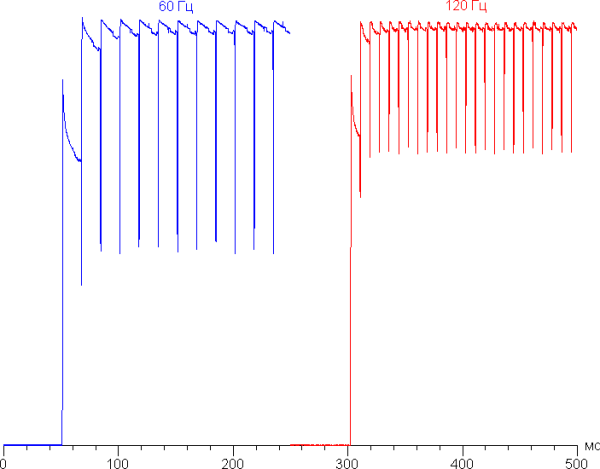
Under certain conditions, the presence of such a step can cause the appearance of plumes that follow moving objects.
A gamma curve constructed using 32 points with equal intervals of numerical values of shades of gray did not reveal any deviations in either shadows or highlights. The exponent of the approximating power function is 2.26, which is slightly higher than the standard value of 2.2. In this case, the real gamma curve practically does not differ from the power-law dependence.
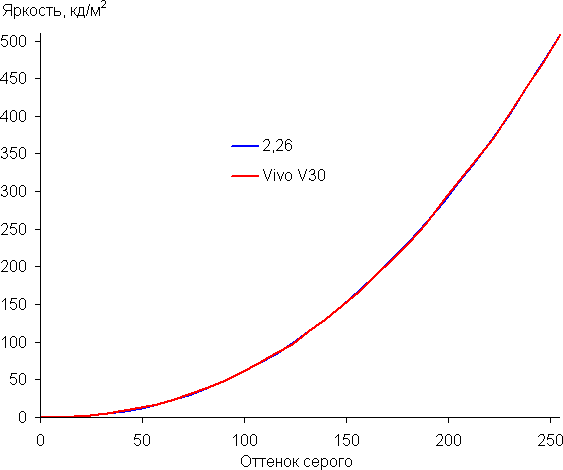
Recall that in OLED screens, the brightness of image fragments dynamically changes depending on the overall nature of the displayed image: it is slightly reduced for areas with bright colors. Therefore, the resulting brightness versus hue curve (gamma curve) is likely to differ slightly from the gamma curve of a static image, since the measurements were taken with sequential grayscale output across almost the entire screen.
The color gamut for the Vivid profile is very wide and exceeds DCI-P3.
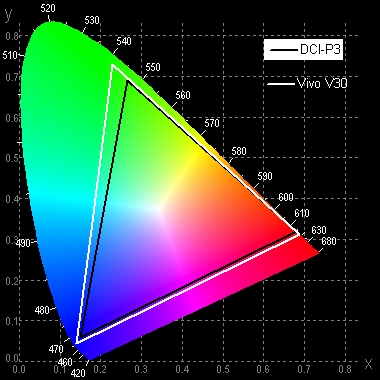
When you select the Pro Mode profile, the coverage is compressed to the sRGB boundaries:
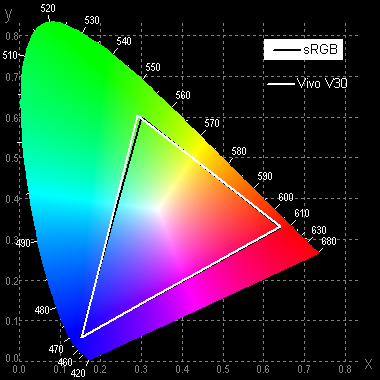
Coverage in the case of the Standard profile is close to the DCI-P3 space:
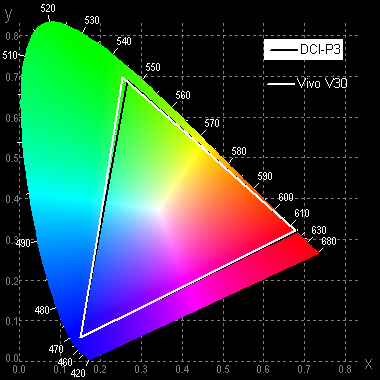
Without correction (the Bright option), the component spectra (that is, the spectra of pure red, green and blue) are very well separated:
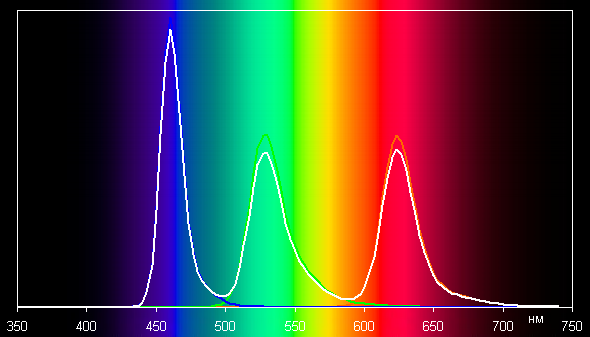
In the case of the Pro Mode profile, the color components are mixed with each other to a large extent:
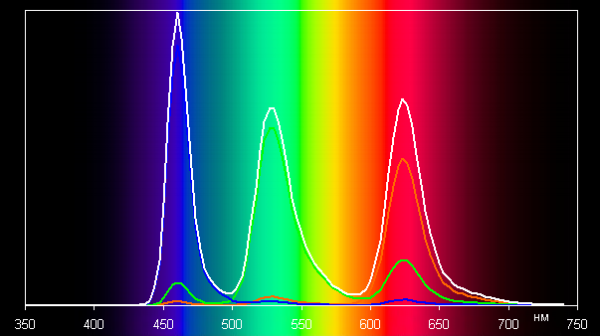
Even without additional correction of the shade balance on the gray scale in the Pro Mode profile, the results are good. The color temperature is close to the standard 6500 K, and the deviation from the blackbody spectrum (ΔE) remains below 10 units, which is considered acceptable for a consumer device. In addition, color temperature and ΔE practically do not change from hue to hue, which has a positive effect on the visual assessment of color balance.
In most cases, the darkest areas of the gray scale can be ignored, since color balance there is not very important, and the error in measuring color characteristics at low brightness is large.
Of course, there is an “Eye Protection” setting that allows you to reduce the intensity of the blue component.

In general, bright light can disrupt the circadian rhythm, but this problem can be solved by reducing the brightness to a comfortable level without distorting the color balance by reducing the contribution of blue light.
This unit does not appear to support DisplayPort Alt Mode for USB Type-C, which means it cannot output image or sound to an external device when connected via USB.
So, the screen has a high maximum brightness (up to 900 cd/m²) and excellent anti-glare properties, which allows you to use the device outdoors even on a bright sunny day. In the dark, the brightness can be reduced to a comfortable level (up to 2 cd/m²). The automatic brightness adjustment mode works adequately. Screen benefits include an effective oleophobic coating, no flicker, 120Hz refresh rate mode, good color balance and sRGB coverage once the appropriate profile is selected.
It's also worth noting the general advantages of OLED screens, such as true blacks, good white field uniformity, and less brightness drop when viewed at an angle. Overall the image quality is very high.
However, it is worth considering that the curved edges of the screen can introduce color distortion and reduce brightness at the edges of the image, which leads to glare in ambient light conditions.
Camera
The Vivo V30 smartphone comes with two rear cameras and one front camera. To create portrait shots, there is an Aura ring LED flash that allows you to adjust the color temperature of the backlight from warm to cool. It is possible to automatically configure this parameter.
The main camera has a resolution of 50 megapixels, uses advanced phase detection autofocus and optical image stabilization. It features a 1/1.55-inch OmniVision sensor. Support for exclusive bionic spectrum technology (vivo camera-bionic system) is mentioned.
By default, photos are taken at 12.5 megapixels using the pixel binning feature. It is possible to switch to shooting in full 50MP resolution, but such photos usually turn out blurry and do not bring a significant improvement in detail.
The main camera exhibits high quality shooting: there is no blur throughout the entire frame area, detail is high, sharpness is good, and the dynamic range is wide. It is possible to change the color rendition from natural to saturated with one button. Rich Color mode gives photos a slightly brighter, more saturated appearance, but the added edge sharpening may be noticeable visually. Overall, although the quality does not reach the level of flagship cameras, it remains at a high level, making the smartphone worthy of the title of sub-flagship.
Night shots look great. Although a more sensitive sensor like the flagship models could provide more detail and less noise, the photos we have already look very good. Plus, they are adequately exposed, making them a great choice even for screensaver use.

Digital zoom is present in this model, although it is centered on the central part of the full-size frame. It's really capable of magnifying detail, especially at 2x, which is the recommended level. However, further zoom values, starting from 20×, can be considered more as a feature for experimentation than for everyday use.
The wide-angle camera performs well in its class. In the center of the frame it provides good detail, and at the edges of the image the quality decreases somewhat, although it remains acceptable. However, the main camera shoots noticeably better and remains the better choice for most situations.
The front camera is equipped with a 50 MP sensor (1/2.76″, 0.64 µm) with autofocus and on-screen flash for various lighting modes. The shooting quality is quite high, with moderate detail, but with adequate lighting and contrast. Despite having only one camera, it can emulate different focal lengths thanks to digital zoom.
Video images may appear less saturated and vibrant than photos, leaning toward paler tones. However, video quality remains at a very high level: high detail, clarity and wide dynamic range are maintained. The smartphone is capable of recording video in a maximum resolution of 4K at 30 frames per second, and the 60 frames per second mode is only available in 1080p format. The combination of electronic (EIS) and optical (OIS) stabilization ensures smooth images when shooting on the go. High-quality sound is also recorded when shooting video.
Telephone and communications
The Vivo V30 smartphone has extensive networking capabilities. It supports most 4G and 5G mobile networks, dual-band Wi-Fi 6 and Bluetooth 5.4, and is also equipped with NFC and e-SIM support. In the urban area of Moscow and its environs, the device demonstrates stable operation in wireless networks, without losing connection and quickly restoring it after a break. Built-in sensors, including a gyroscope, provide a full range of functions.
The satellite navigation module works with GPS, Glonass, BDS, Galileo and QZSS. Primary satellites are quickly detected during a cold start, and the positioning accuracy is not satisfactory.
Voice communication is characterized by loud and clear sound of the interlocutor, and the vibration signal of the call is pleasantly soft.
Software and multimedia
The Vivo V30 smartphone runs on the latest version of the Android 14 operating system, which is complemented by its own Funtouch 14 shell. A large amount of pre-installed software is built in, mainly from Russian sources, with an extensive set of additional functions. For example, the user can choose from four options for backlighting the edges of the screen for notifications and eight animations for the charging icon. The notification shade is single and telescopic, without being divided into two parts. In addition, the device has access to the official Google Play application store and Google services.
The Vivo V30's Gaming Mode offers several features: Game Boost, which improves gaming performance, Battery Saver to save battery, and Do Not Disturb mode, which blocks all incoming calls and notifications, preventing the user from being distracted, especially while playing online games., where you can't pause the game. When starting games, the polling frequency of the touch layer of the display automatically increases to 300 Hz.
In this generation of sub-flagships from Vivo, there is only one speaker left, which may be a drawback for a device of this level. However, the monaural speaker provides very loud and clear sound. The main emphasis here is on wireless headphones, with support for top profiles LDAC, aptX, aptX HD and aptX HD adaptive. For wired headphones, the device does not have a 3.5mm audio output.
Performance
The Vivo V30 smartphone is powered by an octa-core Qualcomm Snapdragon 7 Gen3 processor with Adreno 720 GPU. It comes with 12GB of RAM (including 12GB of virtual memory) and comes with 256GB or 512GB of inbuilt storage. Unfortunately, you cannot install an additional memory card, but it supports connecting external devices via the USB Type-C port in USB OTG mode.
This platform, produced using the 4 nm process technology, is a high-performance mid-range solution that is often used in sub-flagship smartphones. Snapdragon 7 Gen3 easily scores more than 600 thousand points in AnTuTu, which ensures a smooth interface and runs any applications and games without any problems.
The developers note an advanced cooling system, including a large vapor chamber for effective cooling of the smartphone during games, as well as a graphite thermal interface for removing heat from the front camera during online broadcasts or shooting HD video. The smartphone also comes with 11 built-in sensors to monitor temperature in real time and prevent overheating.
Testing in comprehensive tests AnTuTu and GeekBench:
All results obtained during testing of the smartphone were systematized and presented in tables for easy comparison. Typically, such tables include the results of several other devices from different segments, which were also tested on the latest versions of the benchmarks. This is done for a visual comparison with the obtained smartphone indicators. However, due to limitations in the design of the benchmark tests, results from other models tested on previous versions of the programs cannot be included.
| Vivo V30 (Qualcomm Snapdragon 7 Gen3) | Vivo V29 (Qualcomm Snapdragon 778G) | Tecno Camon 20 Pro 5G (Mediatek Dimensity 8050) | Vivo V27 (Mediatek Dimensity 7200) | Poco X5 Pro 5G (Qualcomm Snapdragon 778G) | |
|---|---|---|---|---|---|
| AnTuTu (v9.x) (bigger is better) | 659672 | 544922 | 686367 | 602528 | 536193 |
| GeekBench 6 (bigger is better) | 1117/3160 | 1022/2946 | 1141/3216 | 1198/2686 | 941/2640 |
Testing the graphics subsystem in 3DMark and GFXBenchmark gaming tests:
| Vivo V30 (Qualcomm Snapdragon 7 Gen3) | Vivo V29 (Qualcomm Snapdragon 778G) | Tecno Camon 20 Pro 5G (Mediatek Dimensity 8050) | Vivo V27 (Mediatek Dimensity 7200) | Poco X5 Pro 5G (Qualcomm Snapdragon 778G) | |
|---|---|---|---|---|---|
| 3DMark Wild Life Extreme Vulkan (bigger is better) | 1487 | 687 | 1307 | 1165 | 687 |
| 3DMark Wild Life Vulkan (bigger is better) | 5410 | 2482 | 4538 | 4186 | 2450 |
| GFXBenchmark Aztec Ruins OpenGL (Onscreen, fps) | 56 | ||||
| GFXBenchmark Aztec Ruins Vulkan (Onscreen, fps) | 67 | ||||
| GFXBenchmark Car Chase ES 3.1 (1080p Offscreen, fps) | 48 | ||||
| GFXBenchmark Manhattan ES 3.1 (1080p Offscreen, fps) | 85 | 57 | 91 | 68 | 56 |
| GFXBenchmark T-Rex (1080p Offscreen, fps) | 177 | 134 | 198 | 160 | 132 |
Heat
We test for performance degradation when heated using the Burnout Benchmark program, which allows you to load the CPU, GPU and NPU:
| Stress on | Heating performance as a percentage of maximum |
|---|---|
| CPU | 35% |
| GPU | 66% |
| NPU | 26% |
Battery life
The smartphone comes with a 5000mAh battery, which is considered standard by today's standards. During testing on a modern and well-optimized platform, the device demonstrated high autonomy.
The tests were carried out at normal power consumption levels, without using energy saving functions, although the smartphone has such functions. The screen brightness was set to the minimum comfortable level, approximately 100 cd/m². During testing, the following tests were carried out: continuous reading in the Moon+ Reader application using the standard, light theme; continuous viewing of videos in HD quality (720p); playing Injustice 2 with automatic graphics settings.
| Battery capacity | Reading mode | Video mode | 3D Game Mode | |
|---|---|---|---|---|
| Vivo V30 | 5000 mAh | 23:00 | 21:00 | 8:00 am |
| Vivo V29 | 4600 mAh | 21:00 | 19:00 | 8:30 a.m. |
| Infinix GT 10 Pro | 5000 mAh | 20:30 | 18:00 | 8:30 a.m. |
| Tecno Camon 20 Pro 5G | 5000 mAh | 19:00 | 16:00 | 7:00 am |
| Vivo V27 | 4600 mAh | 25:00 | 19:00 | 7:00 am |
| Poco X5 Pro 5G | 5000 mAh | 18:00 | 20:00 | 7:00 am |
| Realme 10 Pro+ 5G | 5000 mAh | 19:00 | 18:00 | 5:00 a.m. |
| Xiaomi 12T | 5000 mAh | 19:00 | 16:00 | 6:00 am |
| Nothing Phone (1) | 4500 mAh | 15:00 | 16:00 | 5:00 a.m. |
All these data represent maximum values achieved under «ideal» conditions, including no SIM cards installed. Any changes in usage will likely result in reduced results.
Using the included 80W wall charger, the smartphone charges in 47 minutes. There is no support for wireless charging.
Bottom line
This phone offers a gorgeous high-resolution AMOLED screen despite its curved edges, a powerful Qualcomm hardware platform, and a long battery life. The photo quality of the smartphone is also at the highest level, and the larger battery is a great change from previous models. Our only complaint is the lack of stereo speakers, but the single speaker also sounds good enough, especially if you use wireless headphones frequently.

